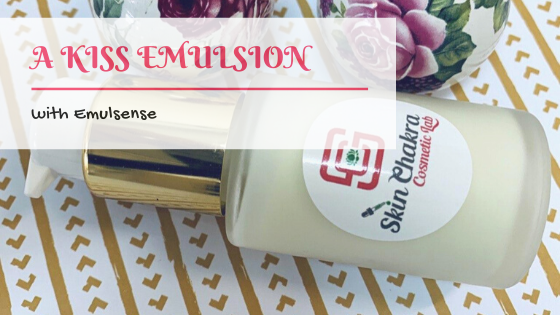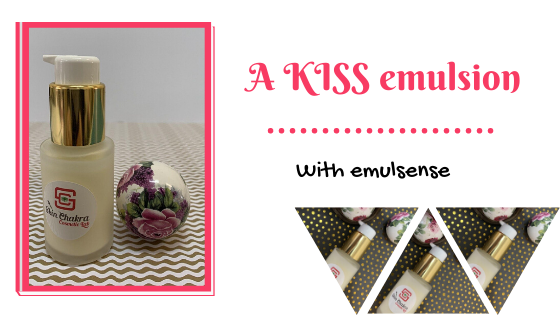If anybody has told me a couple of years ago that I would fall in love with a cationic emulsifier I would have declared him for nuts. It is however true and Emulsense is my favourite emulsifier at the moment. I like the texture of the emulsions, the possibility to vary the viscosity from a milk to a thick cream, the silky skin feel and the fact that it has absolutely no soapiness and no tackiness on the skin.
I have previously shared a formulation which were non KISS and ratehr complicated but today I'm sharing a very KISS formulation for those of you who have never worked with this emulsifier and who follow a "minimalistic" approach in skincare formulation.
Keep in mind that this is the Emulsense emulsifier and not the emulsense HC which is used in hair conditioner. Both ingredients have the same INCI name: Brassicyl Isoleucinate Esylate (and) Brassica Alcohol
They are both palm-free but the ratio between the fatty alcohol and the cationic surfactant is different in them.
Emulsense doesn't need any gum for stabilization. You can use waxes and fatty alcohols to modify the viscosity and improve the stability. If you however decide to use a gum or a gum blend, keep in mind that this is a cationic emulsifier and is not compatible with anionic gums.
Although the formulation and the procedure are very simple and straightforward, there are a few points in this formulation:
1- I'm adding allantoin in the oil phase so that I can apply it at a higher concentration that its solubility in water allows. I add it right before blending the oil and water phase so that I reduce its exposure to heat.
2- I'm adding skin prebiotic to the water phase after I have heated both phases and right before I blend the two phases. This way I can reduce the exposure of this ingredient to heat.
3- I'm using a preservative system that works independent of the pH: Spectrastat G2N
4- I wanted the pH of the product to be between 4,5-5 and by experience I know that this emulsifier imparts a low pH. This means I need to increase the pH. For this purpose I'm using L-Arginin and again based on experience I know it is easier to add it at the beginning to the water phase than trying to adjust the pH at the end. So I've added the arginin from the begining to the water phase.
Now let's jump to the formulation and tutorial.
Formulation:
| Phase A |
|
| Distilled or deionized water |
to 100,0% |
| Panthenol |
1,0% |
| L-Arginin |
0,7% |
| Natural chelator PA-3 |
0,1% |
| Phase B |
|
| Emulsense |
5,0% |
| Brassica alcohol |
2,0% |
| Baobab oil |
15,0% |
| Olive squalane |
5,0% |
| Phase C |
|
| Tocopherol |
0,5% |
| Liquid vit C |
0,5% |
| Spectrastat G2N |
1,0% |
| Rosemary CO2 extract |
0,1% |
| Ylang-ylang oil |
0,8% |
| Litsea cubeba oil |
0,2% |
| Phase D |
|
| Allantoin |
0,5% |
| Phase E |
|
| Skin prebiotic |
3,0% |
Procedure:
1- Heat phase A and B separately in a water bath between 70-75 oC
2- As both phases are heated and all of the solids in phase B are melted stop heating.
3- Dissolve the skin prebiotics in the water phase and disperse allantoin in the oil phase
4- Add the oil phase to the water phase and homogenize
5- Start cooling down under stirring
6- As the emulsion reaches a temperature below 50 degrees add phase C and stir further
7- Prepare a 10% dilution of the emulsion in distilled water and measure the pH. In our case it was exactly in range. If the pH is lower than your desired range you need more L-Arginin to increase the pH and if it is higher than the desired range you need lactic acid to reduce the pH. Have a look at this post about pH measurement.
8- Take your stability and micro kit samples and fill the rest in suitable containers
9- Enjoy the lush skin feel
Watch this video for more information and a step-by-step explanation

BeHappy and have fun



